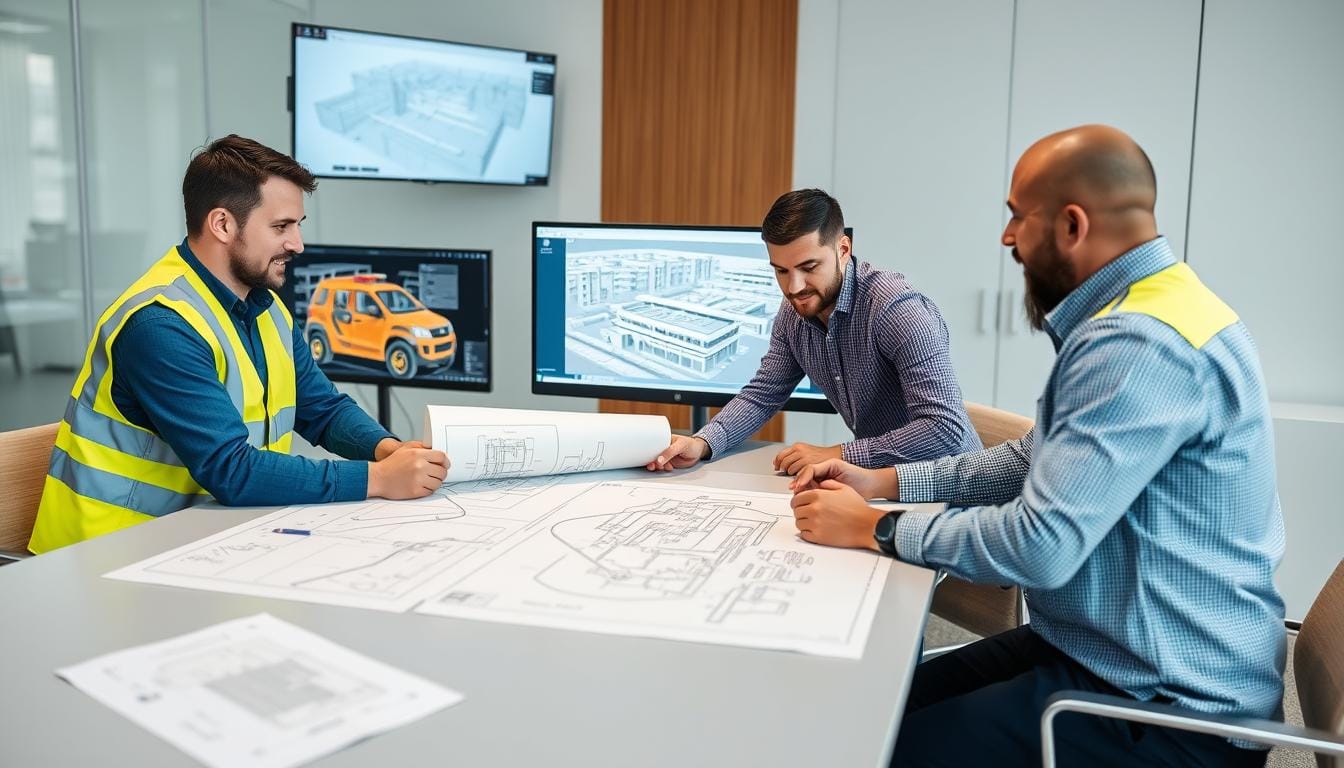
Modern infrastructure projects demand meticulous attention to both civil engineering fundamentals and sophisticated MEP (Mechanical, Electrical, and Plumbing) systems. Understanding these integrated design requirements is crucial for creating safe, efficient, and sustainable structures that meet regulatory standards while delivering optimal performance. This comprehensive guide explores the essential considerations for civil and MEP design requirements that form the backbone of successful infrastructure development.
The Critical Importance of Integrated Civil and MEP Design
The seamless integration of civil engineering and MEP systems is fundamental to creating functional, efficient, and compliant infrastructure. When these disciplines work in harmony, projects benefit from optimized space utilization, reduced conflicts, enhanced sustainability, and streamlined construction processes.

Collaborative approach between civil and MEP engineering teams ensures integrated design solutions
Without proper coordination between civil and MEP design elements, projects risk costly rework, construction delays, compliance issues, and suboptimal performance. The most successful projects approach these requirements as complementary aspects of a unified design strategy rather than separate components.
Civil Design Requirements: Foundation for Modern Infrastructure
Civil design requirements establish the structural integrity and site functionality that support all other building systems. These requirements must account for both immediate construction needs and long-term performance considerations.
Site Planning and Analysis Requirements
Effective site planning forms the foundation of successful civil design. This process involves comprehensive analysis of existing conditions and careful planning for development.

Comprehensive site analysis identifies critical factors affecting civil and MEP integration
| Site Analysis Component | Required Documentation | Impact on MEP Systems |
| Topographical Survey | Contour maps with 1-2 ft intervals | Determines drainage patterns and utility routing |
| Soil Investigation | Geotechnical report with bearing capacity | Affects foundation design for equipment pads |
| Utility Assessment | Existing utility plans and capacity analysis | Determines connection points and service capacities |
| Environmental Factors | Environmental impact assessment | Influences sustainable system selection |
Structural Design Specifications
Structural design requirements ensure the physical integrity of the infrastructure while accommodating MEP systems. These specifications must address load-bearing capacities, material selections, and spatial allocations for MEP integration.

Structural framework designed with dedicated pathways for MEP systems integration
- Load calculations must account for both static and dynamic MEP equipment weights
- Floor-to-floor heights must accommodate ductwork, piping, and cable trays
- Structural penetrations require pre-planning to maintain integrity
- Vibration isolation systems for mechanical equipment must be integrated into structural design
- Seismic requirements affect both structural elements and MEP restraint systems
Civil Infrastructure Requirements
Beyond the building structure itself, civil design requirements extend to supporting infrastructure systems that interface directly with MEP components.
Drainage Systems
Storm water management must be designed with consideration for:
- Retention/detention requirements
- Treatment systems for water quality
- Integration with building drainage
- Flood prevention measures
Utility Corridors
Dedicated pathways for utilities must account for:
- Separation requirements between services
- Access for maintenance and repairs
- Future expansion capabilities
- Protection from physical damage
MEP Design Requirements: Systems for Functionality
MEP design requirements encompass the technical specifications for mechanical, electrical, and plumbing systems that bring a building to life. These requirements must balance performance, efficiency, code compliance, and integration with civil elements.
Need Expert Guidance on Your Project?
Our engineering team specializes in integrated civil and MEP design solutions that optimize performance while ensuring compliance.
Mechanical System Requirements
Mechanical systems provide climate control, ventilation, and specialized process support. Their design requirements focus on performance, efficiency, and integration with the building envelope.

HVAC system design must coordinate with structural elements while meeting performance requirements
HVAC Design Criteria
- Load calculations based on ASHRAE standards
- Zoning requirements for thermal comfort
- Energy efficiency compliance (IECC/ASHRAE 90.1)
- Equipment selection and sizing parameters
- Ventilation rates per ASHRAE 62.1/62.2
System Integration Requirements
- Coordination with structural penetrations
- Space allocation for equipment and distribution
- Access requirements for maintenance
- Noise and vibration control measures
- Interface with building automation systems
Electrical System Requirements
Electrical systems power all building functions and require careful design to ensure safety, reliability, and capacity for current and future needs.

Electrical distribution systems must be designed with capacity, redundancy, and safety in mind
| Electrical Component | Design Requirements | Civil Integration Considerations |
| Power Distribution | Load calculations, voltage drop analysis, selective coordination | Equipment pad locations, conduit pathways, structural support |
| Lighting Systems | Illumination levels per IES, energy code compliance, controls | Ceiling coordination, structural mounting, daylight integration |
| Emergency Power | Backup generation, UPS systems, transfer switches | Generator location, fuel storage, noise isolation |
| Renewable Energy | Solar capacity, inverter specifications, storage systems | Roof loading, equipment mounting, weather protection |
Plumbing System Requirements
Plumbing systems manage water supply, drainage, and specialized process needs. Their design requirements focus on functionality, efficiency, and sanitation.

Plumbing systems require careful coordination with structural elements and other MEP components
- Water supply sizing based on fixture unit calculations
- Drainage system design with proper venting and slopes
- Water pressure requirements and booster systems
- Hot water generation and distribution systems
- Specialized systems (medical gases, process water, etc.)
- Water conservation measures and efficiency requirements
Integration Strategies for Civil and MEP Design Requirements
Successful projects depend on effective integration between civil and MEP design elements. This coordination requires deliberate strategies and tools to ensure all systems work together harmoniously.

BIM technology enables comprehensive coordination between civil and MEP design elements
Building Information Modeling (BIM) Requirements
BIM has become an essential tool for coordinating complex civil and MEP design requirements. Effective BIM implementation requires specific standards and protocols.
- Level of Development (LOD) specifications for each discipline
- Clash detection protocols and resolution procedures
- File sharing and collaboration standards
- Model ownership and liability considerations
- As-built documentation requirements
Optimize Your Design Process
Our team implements advanced BIM coordination to eliminate conflicts between civil and MEP systems before construction begins.
Space Allocation and Coordination Requirements
Effective space planning is critical for accommodating all necessary systems while maintaining accessibility and function.

Ceiling plenum coordination drawing showing allocated spaces for various MEP systems
Vertical Distribution
- Shaft sizing and location requirements
- Floor penetration coordination
- Riser diagram standards
- Access requirements for maintenance
Horizontal Distribution
- Ceiling plenum space allocation
- Corridor utility distribution
- Interstitial space requirements
- Maintenance access clearances
Compliance Standards for Civil and MEP Design Requirements
All Modern Infrastructure projects must adhere to various codes, standards, and regulations that govern both civil and MEP design elements. Understanding these requirements is essential for project approval and public safety.

Code compliance reviews ensure all civil and MEP design elements meet regulatory requirements
Building Code Requirements
Building codes establish minimum standards for safety, accessibility, and performance across all building systems.
- International Building Code (IBC) structural requirements
- International Mechanical Code (IMC) for HVAC systems
- National Electrical Code (NEC) for power and lighting
- International Plumbing Code (IPC) for water and drainage
- International Energy Conservation Code (IECC) for efficiency
- Americans with Disabilities Act (ADA) for accessibility
Sustainability and Energy Efficiency Standards
Modern infrastructure projects increasingly must meet sustainability requirements that affect both civil and MEP design decisions.

Integration of renewable energy sources requires coordination between structural and electrical systems
| Standard/Certification | Civil Design Requirements | MEP Design Requirements |
| LEED | Site selection, storm water management, heat island reduction | Energy performance, water efficiency, indoor air quality |
| WELL Building | Accessibility, outdoor spaces, sound barriers | Air and water quality, thermal comfort, lighting design |
| Net Zero Energy | Building orientation, envelope design, daylighting | Renewable systems, high-efficiency HVAC, smart controls |
| Passive House | Super-insulation, thermal bridge-free design | Heat recovery ventilation, minimal mechanical systems |
Documentation Requirements for Civil and MEP Design
Comprehensive documentation is essential for communicating design requirements, obtaining approvals, and guiding construction. Both civil and MEP design elements require specific documentation standards.

Complete documentation packages ensure clear communication of design requirements to all stakeholders
Drawing Requirements for your Modern Infrastructure
Technical drawings communicate the physical arrangement and specifications of all civil and MEP systems.
Civil Drawing Set
- Site plans with grading and drainage
- Utility plans showing connections
- Structural plans, sections, and details
- Foundation details with equipment pads
- Erosion control and storm water plans
MEP Drawing Set
- HVAC plans, sections, and schematics
- Electrical power and lighting plans
- Plumbing plans and riser diagrams
- Fire protection layout and details
- Control system schematics
Specification Requirements
Technical specifications define the quality, performance, and installation requirements for all systems and components.
- CSI Master Format organization for consistency
- Performance specifications for engineered systems
- Prescriptive specifications for standard components
- Reference standards and testing requirements
- Submittal and quality assurance procedures
- Commissioning and closeout requirements
Ready to Start Your Project?
Our engineering team can help you navigate complex civil and MEP design requirements from concept through construction and Modern Infrastructure.
Implementation Challenges and Solutions
Even with thorough design requirements, implementation often presents challenges that require proactive solutions. Understanding common issues and their resolutions can help ensure successful project execution.

Regular coordination meetings help identify and resolve integration challenges during construction
Common Challenges for Modern Infrastructure
- Spatial conflicts between systems requiring rerouting
- Field conditions differing from design assumptions
- Schedule coordination between civil and MEP trades
- Retrofitting new systems into existing structures
- Balancing budget constraints with performance requirements
- Adapting to regulatory changes during long projects
Effective Solutions
- Comprehensive BIM coordination before construction
- Regular cross-discipline coordination meetings
- Detailed existing conditions surveys
- Phased implementation strategies
- Value engineering with performance prioritization
- Proactive regulatory monitoring and compliance
Quality Assurance and Control Measures
Ensuring that civil and MEP design requirements are properly implemented requires systematic quality assurance and control processes.

Regular quality inspections verify that installations meet design requirements and specifications
- Design review milestones with cross-discipline coordination
- Submittal review process for equipment and materials
- Field inspection protocols and documentation
- Testing and commissioning requirements
- As-built documentation standards
- Post-occupancy evaluation procedures
Conclusion: Integrated Approach to Civil and MEP Design Requirements and Modern Infrastructure
Successful infrastructure projects depend on the seamless integration of civil and MEP design requirements. By approaching these disciplines as complementary aspects of a unified design strategy, project teams can create buildings and facilities that are structurally sound, functionally efficient, and environmentally sustainable.
The key to success lies in comprehensive planning, cross-discipline coordination, and attention to both technical requirements and practical implementation challenges. By leveraging modern tools like BIM while maintaining focus on fundamental engineering principles, design teams can navigate complex requirements and deliver projects that meet both current needs and future demands.
Partner with Experts for Your Next Project
Our engineering consultancy specializes in integrated civil and MEP design solutions that optimize performance while ensuring compliance with all applicable standards and codes. for your Modern Infrastructure



